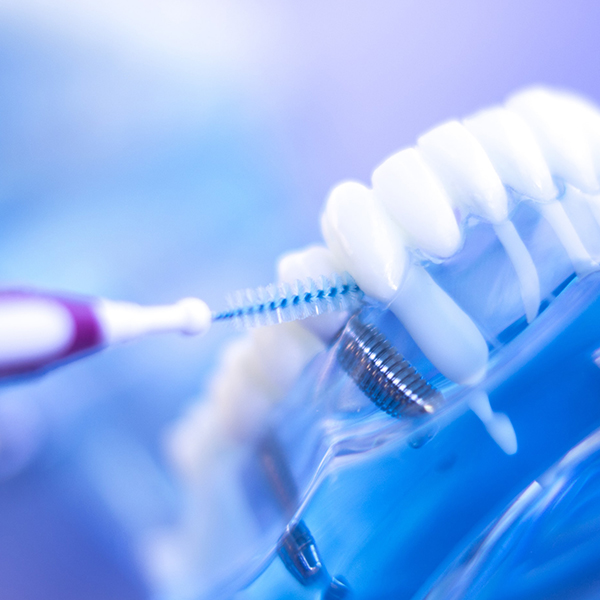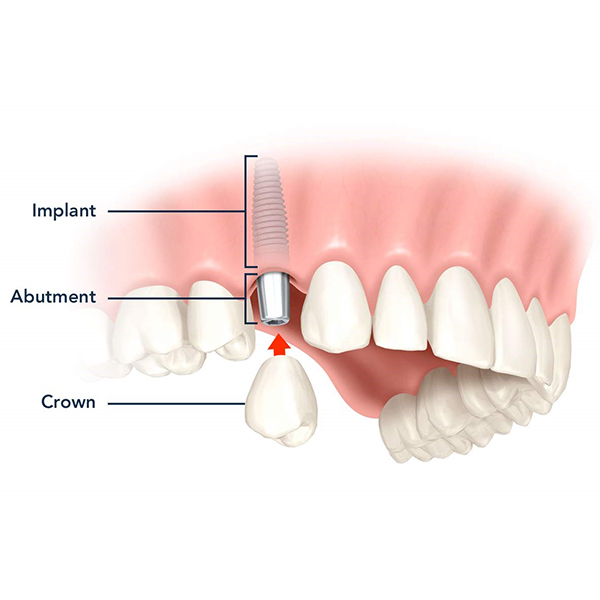Following a dental implant procedure, it is important to plan on the healing process taking a few weeks. During this time, it is recommended that patients stick a soft-food diet and gradually reintroduce harder foods as sensitivity and tenderness diminishes. If your implant was performed due to an injury related to sports, it is also important to strongly consider wearing a mouth guard to prevent similar issues in the future.
Once the implant has fully healed, the most important thing to do to preserve the health and well-being of the implant is to practice the following oral hygiene habits every day.
- Brush twice daily (minimum) and practice proper brushing technique. In addition to brushing regularly, it is also important to brush effectively. Our staff will be happy to answer any questions you may have about proper brushing techniques.
- Floss daily. If you are someone who tends to avoid flossing, you may want to consider flossing alternatives, such as interdental brushes or floss picks.
- Be mindful of your diet. One of the best ways you can prevent dental issues from developing is to avoid foods that are sugary or high in starch. If you do drink soda or sugary beverages, try to use a straw to limit exposure of sugar to your teeth. It is also important to swish your mouth with water following meals, as doing so can dislodge food remnants, which, if left alone can create future tooth decay.
- Schedule regular dental exams. Unchecked dental issues can result in additional issues and progression of decay, which is why it is so important to visit your dentist every six months. In addition to providing a deep clean for your teeth and diagnosing potential issues before they progress, these regular checkups also allow your dentist to monitor the status of your implant.
Dental implants also offer the added benefit of allowing replacement teeth to look, feel, and function like natural teeth.

Cleaning and caring for dental implants are keys to prolonging their appearance and functionality. Failing to properly care for your dental implants can increase the risk for peri-implantitis—an inflammatory condition that affects the soft and hard tissues surrounding implants. When left unaddressed, peri-implantitis can lead to loss of bone and the dental implant. However, cleaning your dental implants regularly can help you minimize your risk for peri-implantitis, and maintain a bright, healthy, and attractive smile for years to come.
Here is a detailed guide on how to clean dental implants, along with extra tips on how to prolong the life of your implants.
Click here if you want to see a detailed video of the oral hygiene procedure with dental implants.
1. Use a Soft-Bristled Toothbrush
Soft bristles are less likely to damage your gums or cause bleeding and are just as effective as medium or hard bristles at removing tartar and plaque. Electric toothbrushes are shown to disrupt and remove bacteria from teeth more effectively than manual toothbrushes due to the way they generate a higher number of brush strokes than the human hand. Regardless of whether you choose an electric or manual toothbrush, make sure it has soft bristles.
2. Brush at Least Twice Per Day
Brushing in the morning after you wake up eliminates morning breath and removes bacteria that has built up in the mouth overnight. Brushing in the evening before bedtime helps remove bacteria that has built up throughout the day and reduces the risk for plaque buildup and decay overnight. Many dentists encourage brushing after every meal, or anytime during the day as needed to remove food debris and bacteria.
3. Use a Water Flosser
Also known as an oral irrigator or dental water jet, a water flosser disrupts and remove bacteria in pocket depths that measure up to 6 mm deep. Many water flossers come with rubber-tip stimulators and other attachments designed to accommodate sensitive gums and effectively clean hard-to-reach areas between teeth. Many dentists recommend water flossers over dental floss, since some brands of floss can shed particles that contribute to peri-implantitis. Be sure to use the water flosser first since you don’t want to blow away the fluoride toothpaste that is introduced during brushing and flossing.
4. Use Crown and Bridge Floss
Crowns and Bridge floss is specially designed to scrub under and around dental implants. It has two stiff nylon ends and a fuzzy middle which gently cleans the dental implant surface and the porcelain that touches the gumline. The stiff ends enable you to insert the floss between the dental implants at the gumline and pull it through to the other side. You can then lean it against the implant surface and rub it side to side. It’s a good idea to use this floss after brushing while the toothpaste residue is still in your mouth. This enables you to distribute the fluoride around the implant, which helps prevent unwanted bacterial growth.
5. Use Low-Abrasive Toothpaste
Use toothpaste that lacks abrasive ingredients such as baking soda or stain-remover agents, since these ingredients may wear on acrylic and remove glaze from porcelain implants. Look for toothpaste specifically made for use on dental implants, or ask your dentist for toothpaste recommendations.
6. Brush Under and Around the Dental Implant Crown
Bacteria and plaque may accumulate under and around the implant crown to increase the risk for peri-implantitis. To reach these areas, try using an angled-neck toothbrush or an interdental brush with a slim head—especially if your implant is located at the back of your mouth.
What is peri-implantitis?
Peri-implantitis is a complication that can happen with dental implants. It’s characterized by an infection and inflammation of the tissue surrounding the dental implant. This complication has two phases: infection and deep inflammation.
- The infection stage: This is when the gum tissue around your implants get infected with bacteria. Swelling, redness, and some bleeding is a sign of this stage, much like gingivitis. Thankfully, this situation can usually be reversed by good home care. If the inflammation is due to some excess dental cement leftover from attaching the prosthesis, then a visit to your dentist to remove the cement can resolve the issue.
- The deep inflammation/infection stage: This is when the situation has been left to its devices for too long, and the infection has reached the bone. When the bone gets compromised from the infection, the support for the implant wanes. This is the stage when there’s bone loss, and bleeding.


